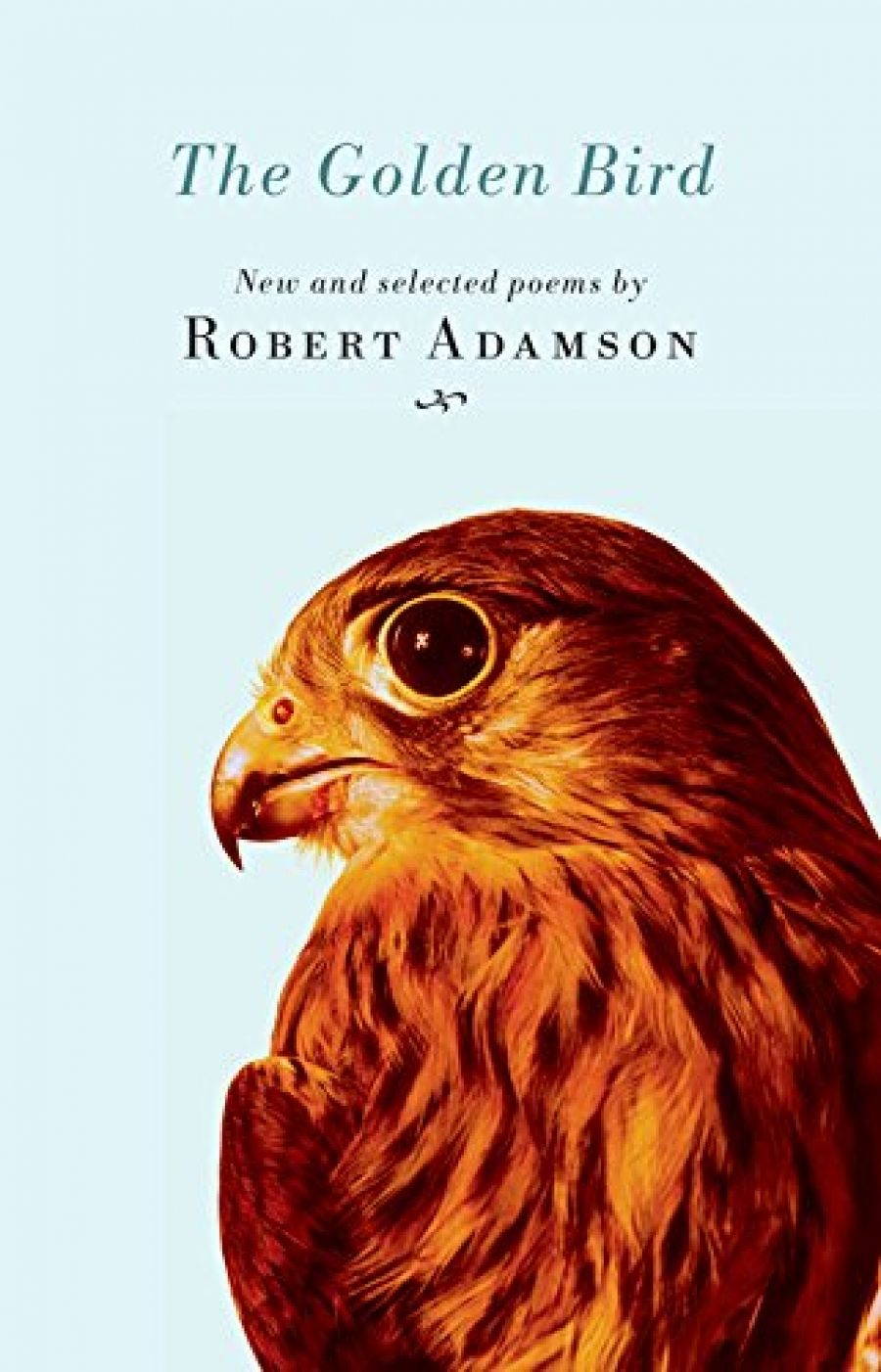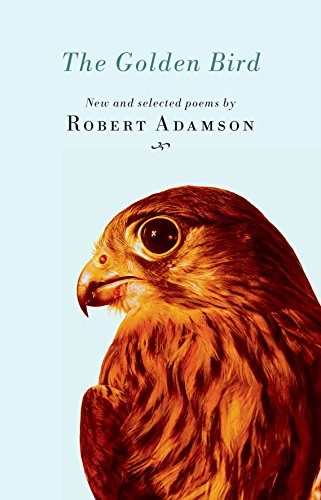
- Free Article: No
- Contents Category: Poetry
- Review Article: Yes
- Article Title: Into the light
- Online Only: No
- Custom Highlight Text:
From his first book Canticles on the Skin (1970) to his twelfth, The Goldfinches of Baghdad (2006), Robert Adamson’s poetry has undergone many transformations, but The Golden Bird, his new and rather large Selected Poems, modifies or disguises those changes by arranging the poems thematically, not chronologically, except for the last section, which contains new poems. Many of Adamson’s early themes have remained throughout his career. Strangely, the sharply witty ‘Sonnets to be Written from Prison’ (‘If I was in solitary I could dream – a fashionable bore, / writing books on drugs, birds or revolution’), from his third book Swamp Riddles (1974), are excluded along with other fine poems, such as ‘Sibyl’ and ‘The Thoughtless Shore’, his elegy to Michael Dransfield, as well as the chapbook Theatre (1974), a response to Yves Bonnefoy’s work of that name.
- Book 1 Title: The Golden Bird
- Book 1 Subtitle: New and selected poems
- Book 1 Biblio: Black Inc., $27.95 pb, 306 pp
- Book 1 Cover Small (400 x 600):

- Book 1 Cover (800 x 1200):

Adamson’s cleverly rhyming sonnets show the craft that is often overlooked in appraisals of his work. It is apparent here in ‘Sonnets for Robert Duncan’ and the unrhymed but complex ‘Not a Penny Sonnets’: ‘The life / we mocked surrounds us – distracted, / but the tide keeps coming in.’ Several of the earlier poems follow formal rhyming schemes – quatrains and sonnets – so effective as to be hardly noticeable. Perhaps these omissions tie in with what Adamson wrote about his poetry in the anthology Landbridge: Contemporary Australian Poetry (1999): ‘I think from now on I will be writing love poems and elegies, trying to make sense of life by offering praise, looking for grace in the meaning of meaning, pushing my eyes into the light’. Many poems, dedicated to other poets or painters – ‘Do we see the world we cannot see through art … so that the image perfects itself / in our seeing it’ – spin around art’s purpose and impulse as well as his own self-mythologising tendencies:
We are still in the car and quibbling
as a wild duck makes an evanescent wake
across the phosphorous tide. The woman turns
to Brett and says: is this decadence? No man,
he mutters, just reflected glory up shit creek.(‘After Brett Whiteley’)
Adamson’s early books, Canticles on the Skin, The Rumour (1971) and Swamp Riddles evoke the era’s social and political change. Underneath his then much-criticised masks and personae (romantic rebel, etc.) Adamson always kept his amused self-consciousness:
Dirty hypodermics rattle in the glove box –
morphine flows over the top of your brain –
an artery collapses – migraine floats out of your eyes.
Alright, there’ll always be glib explanations:
Cashing in on experience again?(‘The Imitator’)
The Vietnam War and the alternating pessimism and protest pervade those books, less overtly than the Iraq invasion in The Goldfinches of Baghdad – ‘The unelected / President’s on the radio again, / laying waste to the world’ – with a bombed Iraq as backdrop for his stranded birds. But these monitory poems are the least typical. Many poems end with the image of a bird or animal, as if art’s purpose is contemplation of nature – or else that vision, inspiration, flies off beyond grasp.
In much of Adamson’s work, the poet is a permeable figure who becomes what he observes – giving the sense that experience and emotion can barely hold his attention or commitment for long, that the poet is always distracted by the shimmering involuntary activity of nature, more riveting in its inevitability than human agency or ambivalence – and requiring less thought. Adamson’s imaginative renderings of birds and fish become the opposite of anthropomorphic – the observed world and the poet’s sensibility leak into each other in an enriching metamorphosis. It is almost as if the natural world is foreground, and the human is background, and that the poet’s thoughts and emotions – if even able to be separated – can have no stable or honest definition:
at night shooting stars draw lines
across the velvet dark
as I hang in a sling of lightbetween the bird’s nocturnal eyes.
(‘The Stone Curlew’)
In the old days I used to think art
that was purely imagined could fly higher
than anything real. Now I feel a small fluttering
bird in my own pulse, a connection to sky …
I stepped into the day, by following your gaze.(‘The Kingfisher’s Soul’)
There are many autobiographical poems – portraits of parents, relatives, friends like the well-known ‘Dreaming up Mother’. Another theme, the book’s penultimate section, is that of Orpheus (‘his song that could once / make rocks weep’) and Eurydice, reiterating the traditional view of art – the desire to build a monument to the past or to what’s passing.
My weakness can’t be measured.
My head contains thousands of images –
slimy mackerel splashing about in the murk.
My failures slip through my fingers pointed
at the best night of my life. This one.
(‘Thinking of Eurydice at Midnight’)
Adamson has many different styles of poems (‘A change of style is a change of subject’: Wallace Stevens), including the bristling, sarcastic poems that revel in the poet’s own self-destruction, and the love poems of his later work (‘My lies are for you, take them utterly, along / with the truth we are explorers for’). The Hawkesbury River that he has made his own is constantly twinned with ‘ink’ – ‘I use the murky river for my ink’, ‘I use the lake / as an inkwell’, ‘Each stroke of the oar stains it / with the inky clouds of thinking’, ‘the river / is like a blank page’, ‘I look out over the incoming tide, dark racks / of oysters jut from its ink.’ Many of Adamson’s poems are so dense with metaphor and images that meaning is almost impenetrable, and they are propelled more by internal rhyme than by narrative or intellect. The new poems are perhaps the clearest and often the most profound. His fishing motif can weary, yet Adamson’s intelligence avoids dropping these poems into a bucket of mush. He has often listed his influences as Mallarmé, Rimbaud, Robert Duncan, Robert Creeley, Hart Crane, Wallace Stevens and Francis Webb, as well as Michael Palmer, whose meditative work strikes an affinity with Adamson’s later books. But many earlier poems also echo poets of his generation: Michael Dransfield, John Tranter, Vicki Viidikas, sometimes Robert Gray and Gary Catalano.
This large selection gives a slightly different view of Adamson – a lyrical romantic poet but more down to earth, gutting fish on the Hawkesbury, the river of his mind. To ignore chronological time as this selection does is to reclaim the past, as he has done in his prose work Inside Out: An Autobiography (2004). Yet this collapsing of time zones muffles the impact of each separate volume. For example, Where I Come From (1979), his fifth book, seemed disingenuously unadorned after previous volumes, and The Clean Dark (1989), his seventh, proved suitably mature and solemn enough to gather prizes.
Their bodies…
slumped on the thousand grooved, fingernailed walls
of your local police station’s cell –
bodies of the street’s larrikin Koories
suspended above concrete in the phenyl-thick air.
(‘Canticle for the Bicentennial Dead’)
Robert Adamson’s poetry is more varied than is generally acknowledged, and this Selected Poems is a good introduction. To find out when individual poems appeared, studious readers will need to refer to the several helpful indexes.


Comments powered by CComment